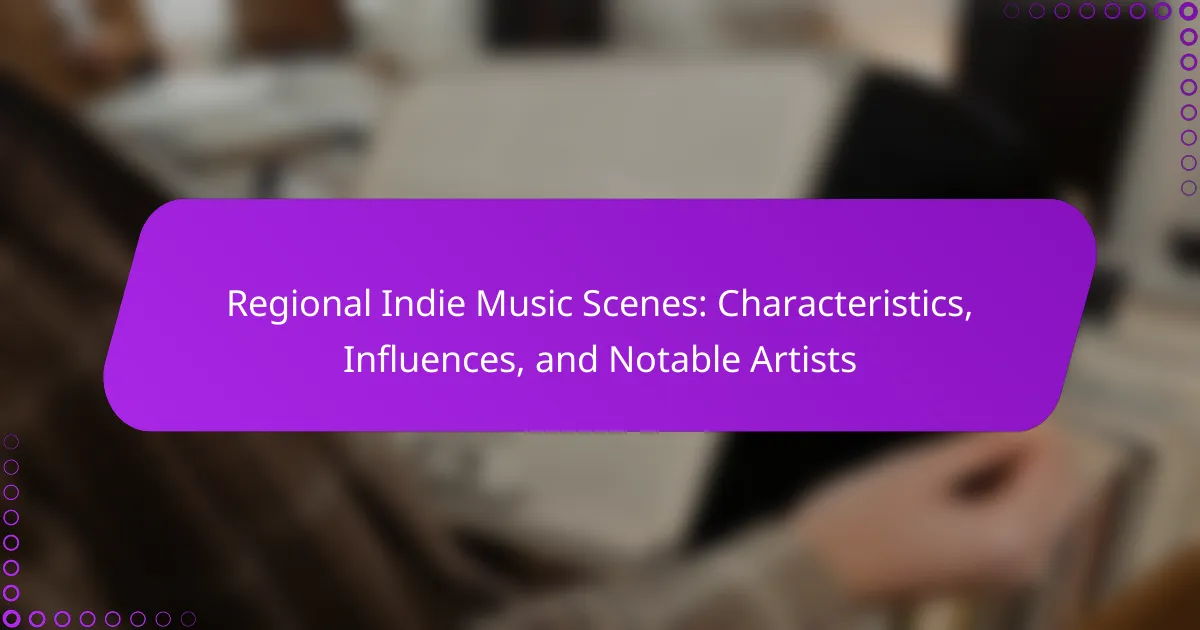Regional indie music scenes offer unique sounds shaped by local culture and community engagement. This article explores their defining characteristics, influences from diverse backgrounds, and notable artists who emerge from these vibrant communities. Additionally, it examines the challenges these scenes face, including funding and audience engagement, while highlighting the role of technology in promoting grassroots movements.
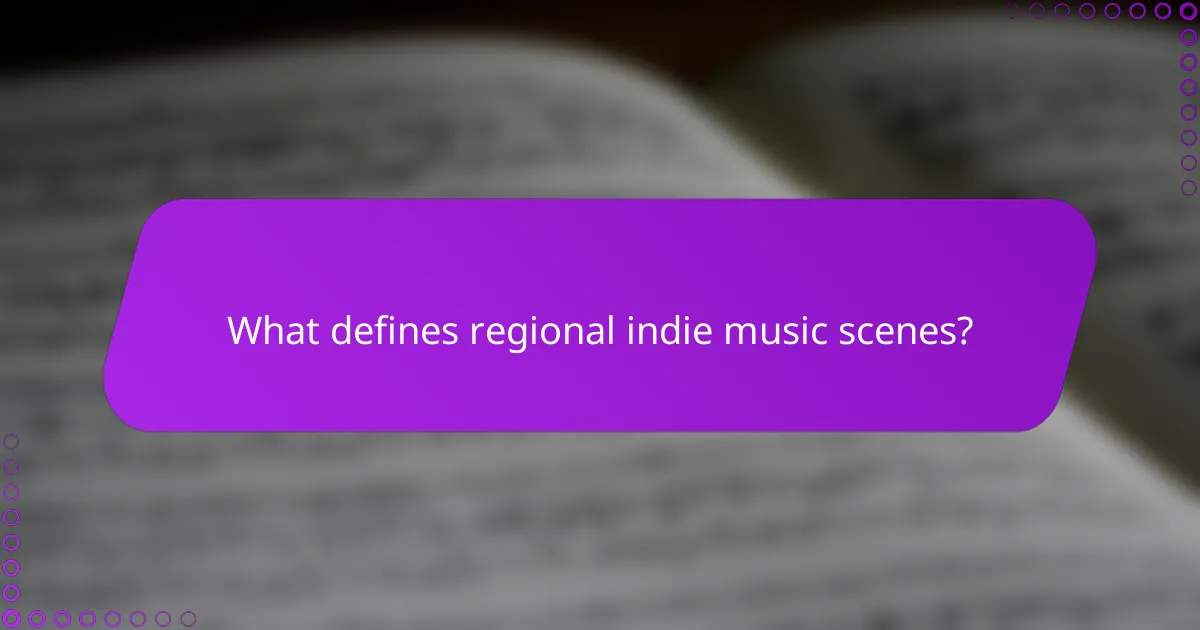
What defines regional indie music scenes?
Regional indie music scenes are defined by their unique characteristics, local influences, and notable artists. These scenes thrive on cultural diversity and community engagement, often reflecting regional stories and sounds.
Key characteristics include a strong sense of local identity, which influences the music style, themes, and performance practices. For example, the folk traditions in the Appalachian region shape its indie sound, while urban areas often blend genres like rock, hip-hop, and electronic music.
Notable artists often emerge from these scenes, gaining recognition for their distinct sounds that resonate with local audiences. The grassroots nature of indie music allows for experimentation, leading to unique artistic expressions that may not fit mainstream trends.
Overall, regional indie music scenes contribute significantly to the broader music landscape by fostering creativity and innovation rooted in local culture.
How do cultural influences shape local sounds?
Cultural influences significantly shape local sounds by blending traditional elements with contemporary styles. Regional indie music scenes reflect the unique heritage, social issues, and artistic expressions of their communities. For instance, folk traditions may merge with modern instrumentation, creating distinct sounds that resonate with local identities. Notable artists often draw inspiration from their cultural backgrounds, infusing their music with narratives that reflect local experiences and values. This interplay fosters a rich diversity within the indie music landscape, showcasing how cultural contexts inform artistic innovation.
What role do community venues play in the development of indie music?
Community venues are vital in developing indie music by providing platforms for local artists to perform and connect with audiences. These spaces foster collaboration and creativity, enabling musicians to experiment and refine their sound.
Local venues often host open mic nights and showcases, which encourage emerging talent to gain exposure. This grassroots support is essential for building regional indie music scenes. Notable artists frequently credit these venues as crucial in their early careers, highlighting their role in nurturing talent.
Furthermore, community venues often reflect unique cultural influences, shaping the indie music landscape in specific regions. They serve as hubs for networking, collaboration, and cultural exchange, enriching the overall music scene.
Which genres are commonly associated with regional indie music?
Regional indie music is often associated with genres like folk, rock, pop, and electronic. Each region influences the sound, leading to unique blends. For example, the Pacific Northwest features a mix of folk and rock, while Southern indie scenes often incorporate country elements. Additionally, regional themes and cultural references shape the lyrical content, enriching the overall experience.
What are the common themes found in lyrics across different regions?
Common themes in lyrics across different regions often include love, social issues, cultural identity, and personal struggles. Regional influences shape these themes, reflecting local traditions and experiences. For instance, folk music may emphasize storytelling and community, while urban genres might focus on contemporary challenges. Notable artists often emerge from these scenes, bringing unique perspectives that resonate with their audiences.
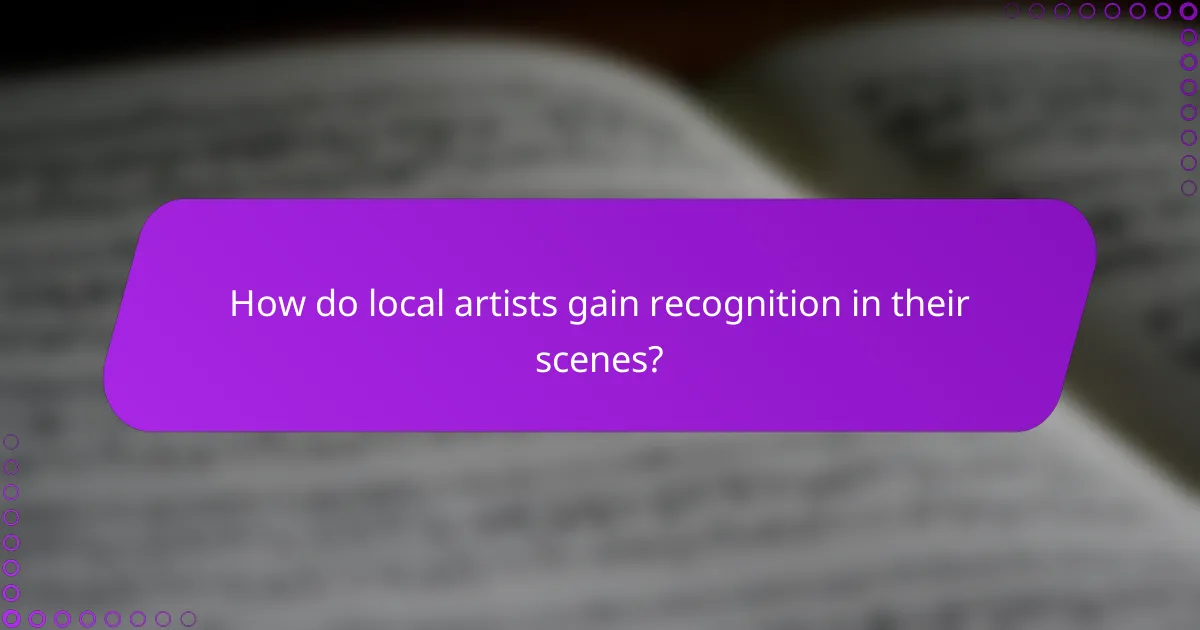
How do local artists gain recognition in their scenes?
Local artists gain recognition through community engagement, collaborations, and unique sound development. They often perform at local venues and festivals, building a loyal fan base. Networking with other musicians and leveraging social media enhances their visibility. Unique attributes, such as distinct musical styles or cultural influences, set them apart and attract attention.
What platforms are most effective for indie artists to promote their music?
Social media platforms like Instagram, TikTok, and YouTube are most effective for indie artists to promote their music. These platforms enable artists to engage with audiences through visual content and short videos. Instagram’s visual appeal allows for storytelling, while TikTok’s viral nature helps reach broader audiences quickly. YouTube serves as a comprehensive platform for music videos and artist branding. Additionally, Bandcamp offers a unique space for direct music sales and fan interaction, catering specifically to indie artists.
How do collaborations with local businesses enhance visibility?
Collaborations with local businesses enhance visibility by creating mutual promotional opportunities. These partnerships allow regional indie music scenes to tap into local networks, attracting new audiences. Events co-hosted with local businesses can draw in their customer base, increasing foot traffic and exposure for indie artists. Additionally, shared marketing efforts amplify reach, engaging communities and fostering a sense of local pride.
Which music festivals are pivotal for showcasing regional talent?
Several music festivals are crucial for highlighting regional talent, including South by Southwest (SXSW), Coachella, and Lollapalooza. These events not only feature local artists but also provide platforms for networking and exposure. Festivals like Newport Folk Festival and Bonnaroo focus on indie genres, showcasing emerging artists alongside established acts. Additionally, regional festivals such as the Americana Music Festival and the Great American Music Festival emphasize local sounds and cultural influences, enriching the music scene.
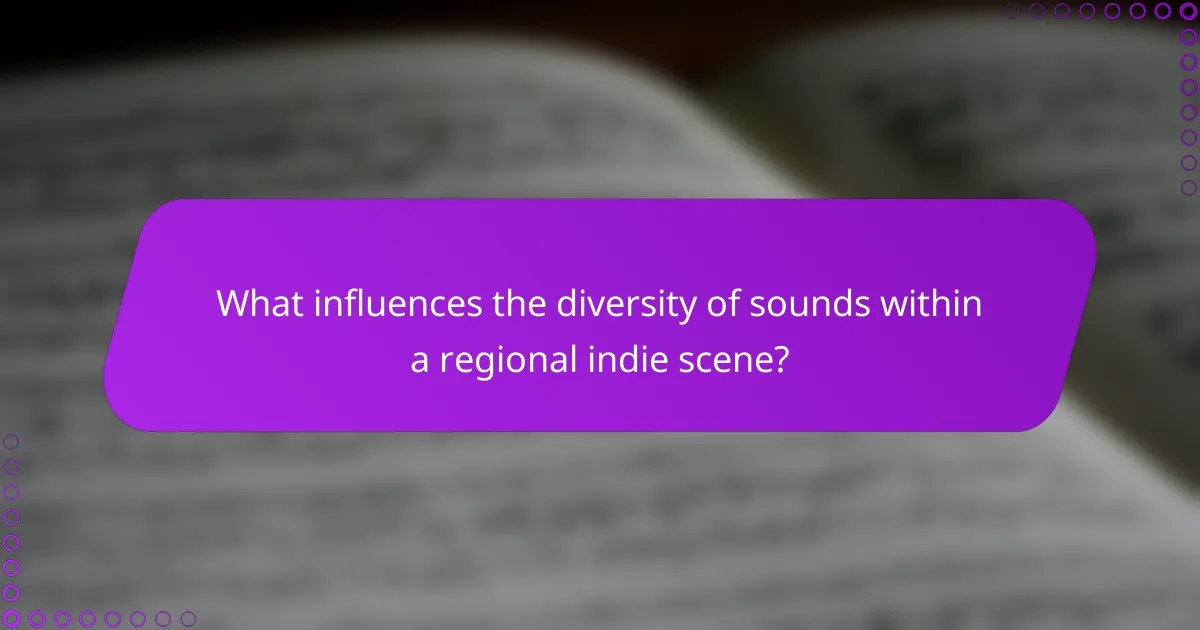
What influences the diversity of sounds within a regional indie scene?
Regional indie music scenes are influenced by local culture, community engagement, and access to resources. Cultural diversity shapes sound variety, as different genres and styles emerge from unique backgrounds. Community involvement fosters collaboration among artists, leading to innovative sounds. Access to recording facilities and live venues enhances exposure and experimentation, further diversifying the musical landscape.
How do socio-economic factors impact the music produced?
Socio-economic factors significantly shape the music produced in regional indie scenes. Economic conditions influence access to resources, venues, and recording opportunities. For instance, artists in affluent areas may have better access to high-quality production tools, while those in economically challenged regions often rely on grassroots methods. Cultural diversity in socio-economic backgrounds enriches the music, leading to unique sounds and themes. Notable artists often emerge from these environments, reflecting local struggles and stories.
What unique instruments or styles emerge in specific regions?
Unique instruments and styles vary significantly across regional indie music scenes. For instance, the use of the ukulele is prominent in Hawaiian indie music, while the banjo features heavily in Appalachian folk influences. In the UK, the incorporation of traditional instruments like the accordion is common in folk-infused indie tracks. Additionally, distinctive vocal styles, such as the use of call-and-response in African indie music, showcase cultural influences. Each region’s unique sounds enhance its musical identity, reflecting local traditions and social narratives.
Which notable artists have emerged from various indie scenes?
Notable artists from various indie scenes include Bon Iver, Arcade Fire, and Fleet Foxes. Each artist reflects unique regional influences and characteristics. Bon Iver emerged from the Wisconsin indie scene, blending folk and electronic elements. Arcade Fire, hailing from Montreal, is known for its eclectic instrumentation and emotional depth. Fleet Foxes, rooted in Seattle, showcases rich harmonies and a connection to nature. These artists exemplify the diverse sounds and cultural backgrounds within indie music.
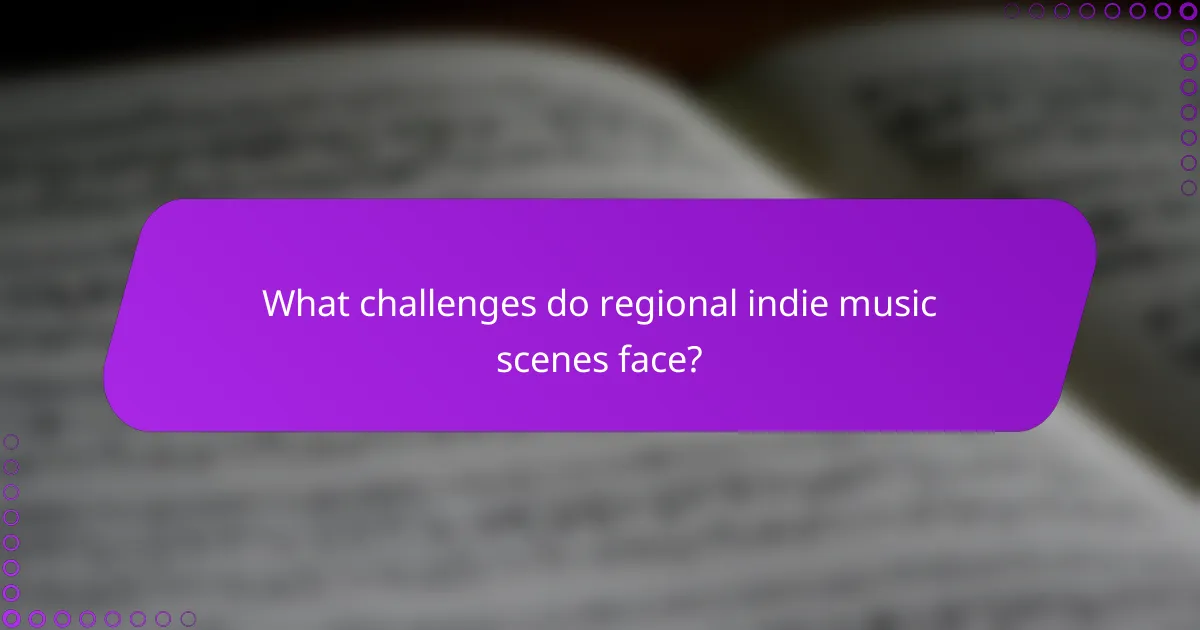
What challenges do regional indie music scenes face?
Regional indie music scenes face challenges such as limited funding, competition from mainstream music, and lack of exposure. These factors hinder the growth and sustainability of local artists. Additionally, regional scenes often struggle with audience engagement and venue availability, which are critical for live performances. As a result, many artists may find it difficult to establish a strong presence outside their local area.
How does funding affect the sustainability of local music initiatives?
Funding significantly enhances the sustainability of local music initiatives by providing essential resources. Financial support enables artists to create, promote, and distribute their work effectively. It also facilitates venue operations, marketing efforts, and community outreach programs. For example, initiatives with stable funding often attract more diverse talent and foster greater audience engagement. Additionally, consistent financial backing can lead to long-term partnerships with local businesses and cultural organizations, strengthening the regional indie music scene.
What barriers exist for artists trying to break into larger markets?
Artists face multiple barriers when trying to break into larger markets. Limited access to resources, such as funding and professional networks, hinders their growth. Additionally, regional indie music scenes often lack exposure, making it difficult for artists to reach wider audiences. Unique attributes of local cultures may not resonate with mainstream tastes, creating challenges in marketability. Furthermore, competition from established artists and labels can overshadow emerging talent, making it harder to gain recognition.
How does competition among local artists influence creativity?
Competition among local artists enhances creativity by fostering innovation and collaboration. This environment encourages musicians to explore diverse styles and push artistic boundaries. As artists strive to distinguish themselves, they often experiment with new sounds, leading to a richer cultural tapestry within regional indie music scenes. Collaborative projects become more common, resulting in unique blends of genres that reflect the community’s identity.
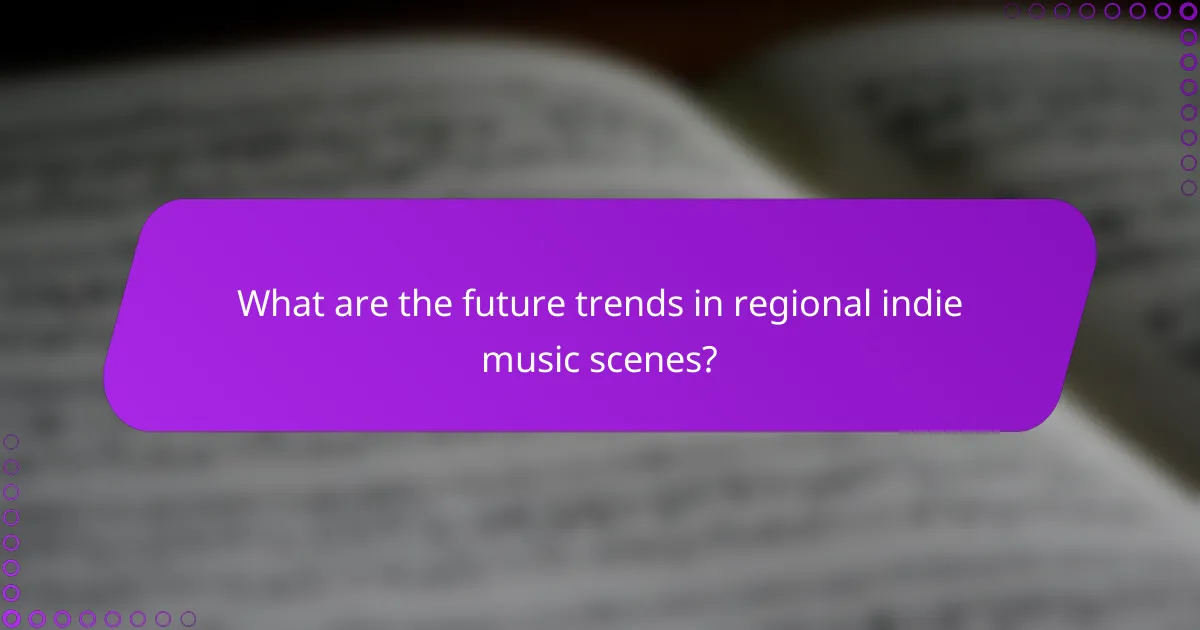
What are the future trends in regional indie music scenes?
Regional indie music scenes are increasingly influenced by technology, collaboration, and diverse cultural exchanges. Artists are utilizing digital platforms for distribution and promotion, allowing for greater reach and engagement. Local collaborations among musicians foster unique sounds that reflect regional identities. Additionally, the rise of social media has enabled grassroots movements, amplifying underrepresented voices in the indie music landscape.
How is technology reshaping the way music is produced and consumed?
Technology is significantly transforming music production and consumption through digital tools and platforms. Regional indie music scenes benefit from affordable recording software, enabling artists to produce high-quality music independently. Streaming services have expanded audiences, allowing niche genres to thrive globally. Social media facilitates direct artist-fan interactions, fostering community engagement. Notable artists like Bon Iver and Sufjan Stevens exemplify how technology enhances creative processes and distribution methods. This shift democratizes music, giving rise to diverse sounds and innovative collaborations across regions.
What role does social media play in the evolution of indie music?
Social media significantly influences the evolution of indie music by enabling artists to connect directly with audiences. It democratizes music distribution, allowing regional indie scenes to thrive. Platforms like Instagram and TikTok showcase unique local sounds, fostering community engagement. Notable artists often gain visibility through viral trends, amplifying their reach beyond traditional media. Social media also facilitates collaboration, enabling diverse influences to merge within indie music.
Which emerging artists are poised to lead the next wave of regional indie music?
Emerging artists like Phoebe Bridgers, Snail Mail, and Yves Tumor are leading the next wave of regional indie music. Their unique sounds reflect diverse influences and resonate with audiences seeking authenticity. Bridgers’ introspective lyrics, Snail Mail’s melodic guitar work, and Tumor’s genre-blending approach showcase the evolving landscape of indie music. Regional scenes are increasingly influenced by local culture and social issues, fostering a rich tapestry of creativity. As these artists gain traction, they highlight the importance of community and connection in the indie music movement.
What best practices can indie artists adopt to thrive in their local scenes?
Indie artists can thrive in local music scenes by building strong community connections, collaborating with other musicians, and actively participating in local events. Engaging with fans through social media and live performances enhances visibility. Establishing a unique sound that reflects regional influences attracts local audiences. Regularly releasing new music keeps the momentum going and fosters a dedicated fan base.
